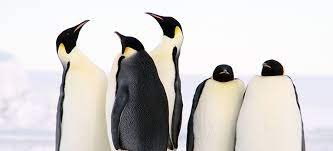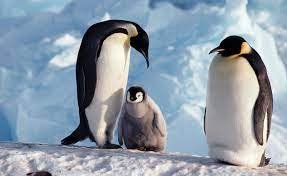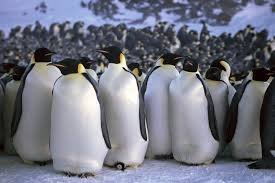The penguins on land are called a colony or rookery, and the penguins in the water are called a Waddle. A raft is a group of penguins out on the water. These clusters of chicks are called creches, and they stick together for the sake of warmth until their feathers grow in.

A colony of penguins may seem disorganized and noisy, but each member of the colony has the ability to recognize another. A “swarm,” “swarming,” or “murder” of crows. There is a plethora of options for classifying animals. Herds and packs are two common examples, while a “smack” of jellyfish or an “embarrassment” of pandas are two examples of less conventional groupings. These labels typically originate from peculiar or remarkable characteristics of the people they describe. A group of porcupines might “prickle,” or a group of otters might “romp,” as two examples.
Other terms for a group of penguins

- A formality of penguins
- A huddle of penguins
- An icing of penguins
- A march of penguins
- A muster of penguins
- A parade of penguins
- A parcel of penguins
- A pride of penguins
- A rookery of penguins
- A shiver of penguins
- Tobogganing of penguins
- A town of penguins
- A tuxedo of penguins
The common belief that penguin colonies form primarily for the purpose of providing warmth to their members is only part of the story. While some penguins, like Emperor penguins, huddle in large colonies to fend off the bitter cold of Antarctica, others, like Galapagos penguins, Humboldt penguins, and African penguins, prefer warmer climates. In fact, it’s more common to see them fighting to maintain a comfortable body temperature. Therefore, it appears that penguins’ propensity for social behavior is not solely a function of living in chilly environments.
As flightless birds, penguins can only live in a limited range of environments, which forces them to colonize in groups. They are unable to fly great distances, so they tend to stick to the same nesting grounds from generation to generation. Because of their limited range compared to avian species, they have likely evolved to coexist.
Hundreds, if not thousands, of penguins will gather on land to breed or for other reasons during the breeding season. The collective breeding of many individuals is known as a colony or rookery. In general, penguins are very faithful to their nesting sites, returning to the same one year after year.
Also, know about Barred Owl Nesting
12 Interesting Details About Penguins

- In addition to World Penguin Day on April 25th, there is also Penguin Awareness Day on January 20th.
- Penguins in the water are referred to as a “raft,” while penguins on land are referred to as a “waddle.” Penguin colonies, huddles, and rookeries are all other terms for groups of these birds.
- Third, penguins’ supraorbital glands, located above and behind their eyes, filter seawater out of their bloodstream, causing them to sneeze when they accidentally swallow it while diving for fish.
- When compared to other penguin species, the Gentoo penguin’s tail is the most pronounced and sweeps from side to side as it waddles, earning it the Latin name Pygoscelis (brush-tailed).
- Five, wild penguins in Antarctica aren’t overly scared of humans because they aren’t in danger when they’re on land. They will most likely come and check on you if you don’t move.
- Six, while all but one penguin species can be found in the Southern Hemisphere, the Galapagos penguin is the only one to be found north of the equator due to being endemic to the Galapagos Islands.

- In 2008, the King of Norway knighted a king penguin at the Edinburgh Zoo. Sir Nils Olav is currently the Norwegian Guard’s Colonel-in-Chief.
- In the water, Gentoo penguins can travel as fast as 22 miles per hour, making them the fastest of all penguin species. Between 4 and 7 miles per hour, most penguins can travel.
- Nine, penguins tend to mate with the same person of the opposite sex year after year. Penguins show the same degree of devotion to their nesting grounds as humans do when they are raising young, often returning to the same rookery.
- Penguins use their distinct mating calls to find their partners in the densely populated breeding grounds. When a penguin chick is born, both parents take care of it for several months until it is mature enough to go out and find food on its own.
- Rather than teeth, penguins use the lateral, fleshy spines that line the inside of their mouths to guide fish down their oesophaguses. A medium-sized penguin’s daily diet of fish, squid, crabs, krill, and other seafood averages 1 kilogram (kg) in the summer and 0.3 kg (kg) in the winter.
- Twelve, with the exception of two species, penguins form large breeding colonies of hundreds to thousands of individuals. About two million chinstrap penguins breed on Zavodovski Island in the South Sandwich Islands (Antarctica), making it the world’s largest penguin colony, as verified by Guinness World Records.
Some wildlife experts claim that penguins are among the world’s most aerodynamic creatures. In addition to its long, elongated body, a penguin has a large head and a relatively short neck. To aid their speed in the water, penguins have streamlined their bodies.
When a penguin is floating on the water, it is probably referred to as a raft. During this time, penguins are the least likely to interact with one another; instead, they prefer to spend their time hunting alone or floating alone in the water, preening, or simply relaxing.





